Around the mid-1930s and in the context of the publication of the Report of the Joint Committee on Materials for Research of the Social Science Research Council and the American Council of Learned Societies, several university libraries, such as Harvard, Yale, Duke and Chicago installed on-site microfilm laboratories. This development was spurred by the involvement of a young and well-connected generation of librarians such as Hermann H. Fussler, Llewellyn Raney and Robert C. Binkley, who were members in the newly established microfilm committee of the American Library Association (ALA). Llewellyn Raney, for instance, was the chairman of the ALA Committee on Photographic reproduction of library material and Hermann H. Fussler coordinated the presentation of the latest microfilm technologies by US-American companies and institutions at the Paris Exposition in 1938. The creation of a network between institutions, professional associations and the photo industry was instrumental as it paved the way for the testing, application and standardisation of processes. All these efforts were greatly sustained by the Rockefeller Foundation and the Carnegie Foundation, which subsidized the new technology during its experimental phase and at a time when public funding for all Library activities was scarce. For the Carnegie Foundation the support for microphotography was in line with their role as benefactor of the public libraries in the United States, whereas the involvement of the Rockefeller Foundation mirrored the reorientation of its Humanities program. From the 1930s on, it directed its support toward the use of new media such as radio, photography and film within their programs.
Evaluating and prospecting
Microphotography. A Lay Appraisal
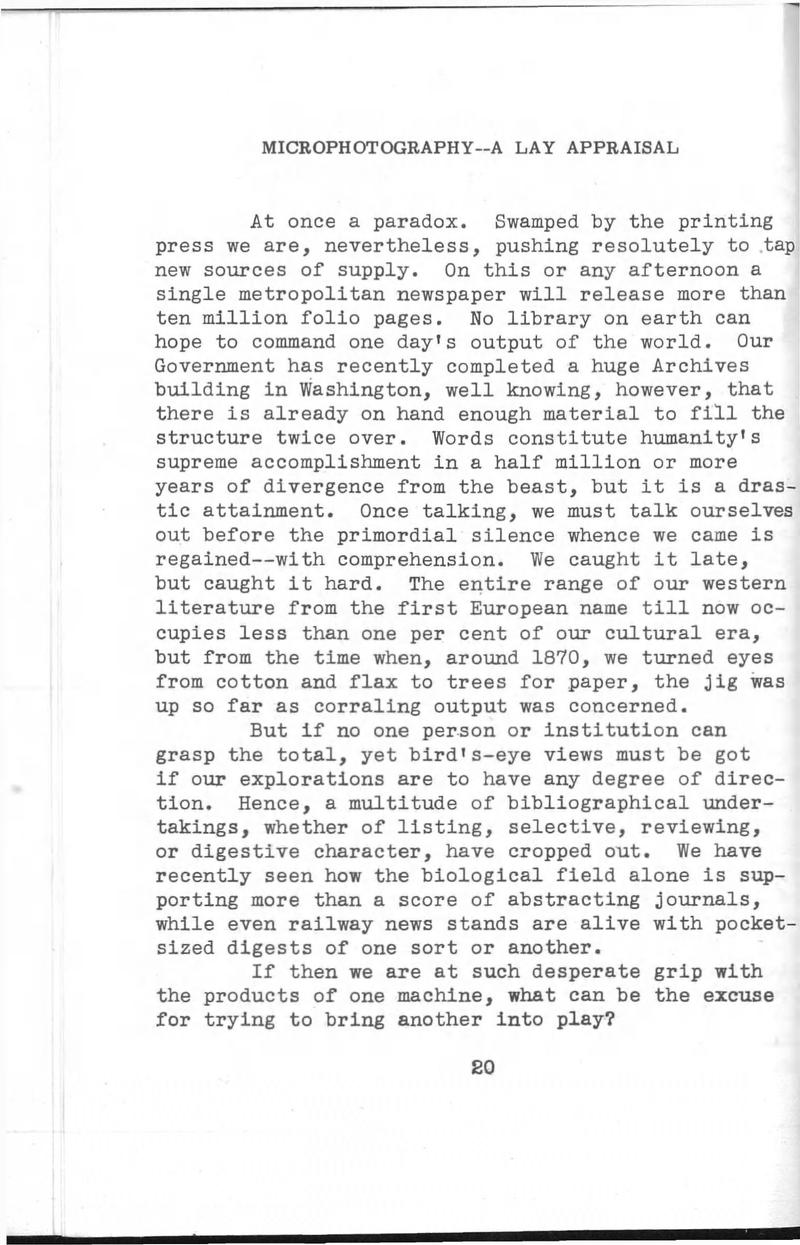
[p. 20] At once a paradox. Swamped by the printing press we are, nevertheless, pushing resolutely to tap new sources of supply. On this or any afternoon a single metropolitan newspaper will release more than ten million folio pages. No library on earth can hope to command one day’s output of the world. Our Government has recently completed a huge Archives building in Washington, well knowing, however, that there is already on hand enough material to fill the structure twice over. Words constitute humanity’s supreme accomplishment in a half million or more years of divergence from the beast, but it is a drastic attainment. Once talking, we must talk ourselves out before the primordial silence whence we came is regained - with comprehension. We caught it late, but caught it hard. The entire range of our western literature from the first European name till now occupies less than one per cent of our cultural era, but from the time when, around 1870, we turned eyes from cotton and flax to trees for paper, the jig was up so far as corralling output was concerned.
But if no one person or institution can grasp the total, yet bird’s-eye views must be got if our explorations are to have any degree of direction. Hence, a multitude of bibliographical undertakings, whether of listing, selective, reviewing, or digestive character, have cropped out. We have recently seen how the biological field alone is supporting more than a score of abstracting journals, while even railway news stands are alive with pocketsized digests of one sort or another.
If then we are at such desperate grip with the products of one machine, what can be the excuse for trying to bring another into play?
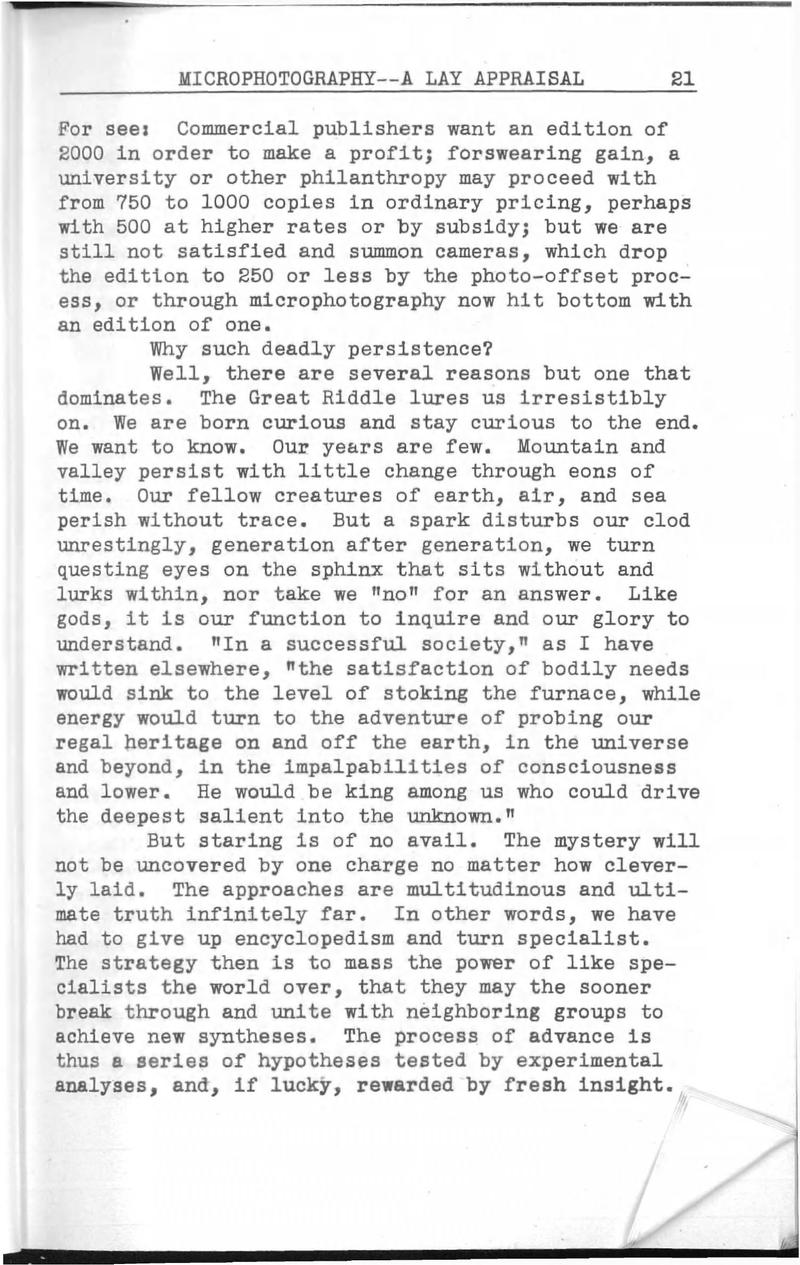
[p. 21] For see: Commercial publishers want an edition of 2000 in order to make a profit; forswearing gain, a university or other philanthropy may proceed with from 750 to 1000 copies in ordinary pricing, perhaps with 500 at higher rates or by subsidy; but we are still not satisfied and summon cameras, which drop the edition to 250 or less by the photo-offset process, or through microphotography now hit bottom with an edition of one.
Why such deadly persistence?
Well, there are several reasons but one that dominates. The Great Riddle lures us irresistibly on. We are born curious and stay curious to the end. We want to know. Our years are few. Mountain and valley persist with little change through eons of time. Our fellow creatures of earth, air, and sea perish without trace. But a spark disturbs our clod unrestingly, generation after generation, we turn questing eyes on the sphinx that sits without and lurks within, nor take we “no” for an answer. Like gods, it is our function to inquire and our glory to understand. “In a successful society,” as I have written elsewhere, “the satisfaction of bodily needs would sink to the level of stoking the furnace, while energy would turn to the adventure of probing our regal heritage on and off the earth, in the universe and beyond, in the impalpabilities of consciousness and lower. He would be king among us who could drive the deepest salient into the unknown.”
But staring is of no avail. The mystery will not be uncovered by one charge no matter how cleverly laid. The approaches are multitudinous and ultimate truth infinitely far. In other words, we have had to give up encyclopedism and turn specialist. The strategy then is to mass the power of like specialists the world over, that they may the sooner break through and unite with neighboring groups to achieve new syntheses. The process of advance is thus a series of hypotheses tested by experimental analyses, and, if lucky, rewarded by fresh insight. 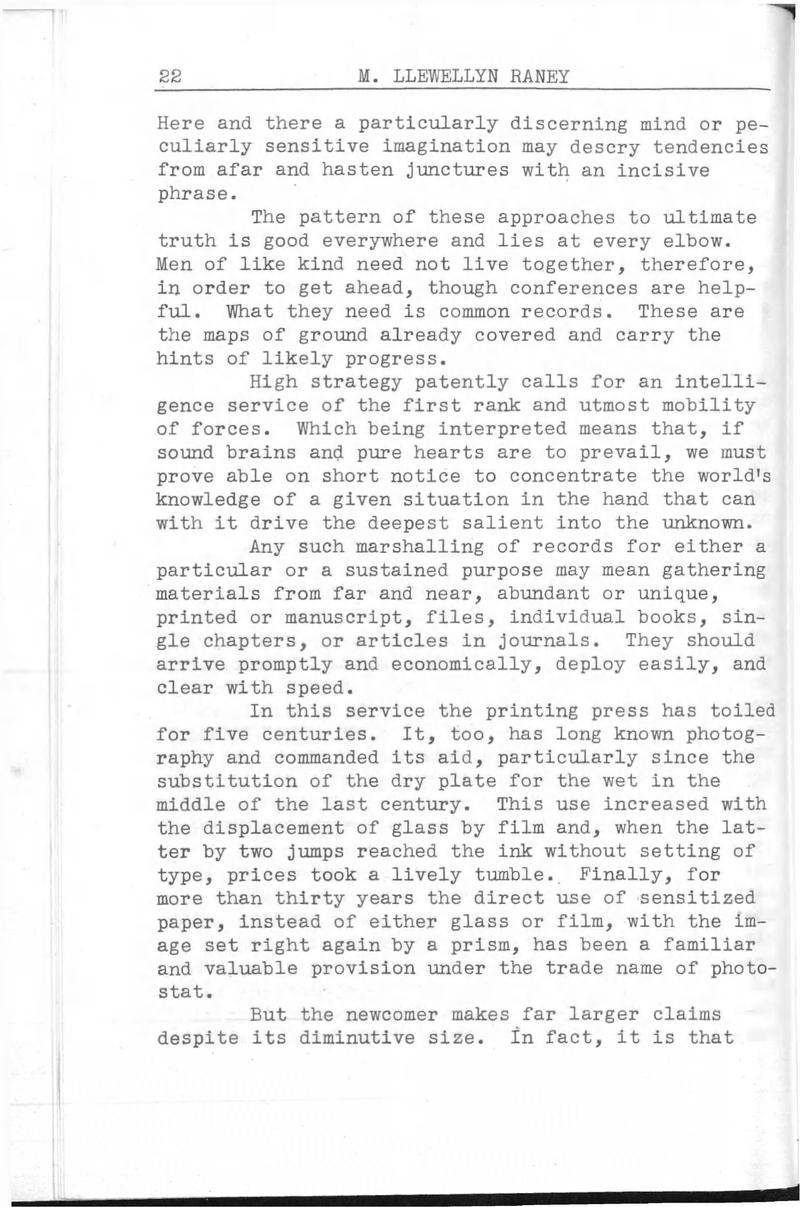 [p. 22] Here and there a particularly discerning mind or peculiarly sensitive imagination may descry tendencies from afar and hasten junctures with an incisive phrase.
[p. 22] Here and there a particularly discerning mind or peculiarly sensitive imagination may descry tendencies from afar and hasten junctures with an incisive phrase.
The pattern of these approaches to ultimate truth is good everywhere and lies at every elbow. Men of like kind need not live together, therefore, in order to get ahead, though conferences are helpful. What they need is common records. These are the maps of ground already covered and carry the hints of likely progress.
High strategy patently calls for an intelligence service of the first rank and utmost mobility of forces. Which being interpreted means that, if sound brains and pure hearts are to prevail, we must prove able on short notice to concentrate the world’s knowledge of a given situation in the hand that can with it drive the deepest salient into the unknown.
Any such marshalling of records for either a particular or a sustained purpose may mean gathering materials from far and near, abundant or unique, printed or manuscript, files, individual books, single chapters, or articles in journals. They should arrive promptly and economically, deploy easily, and clear with speed. In this service the printing press has toiled for five centuries. It, too, has long known photography and commanded its aid, particularly since the substitution of the dry plate for the wet in the middle of the last century. This use increased with the displacement of glass by film and, when the latter by two jumps reached the ink without setting of type, prices took a lively tumble. Finally, for more than thirty years the direct use of sensitized paper, instead of either glass or film, with the image set right again by a prism, has been a familiar and valuable provision under the trade name of photostat.
But the newcomer makes far larger claims despite its diminutive size. In fact, it is that 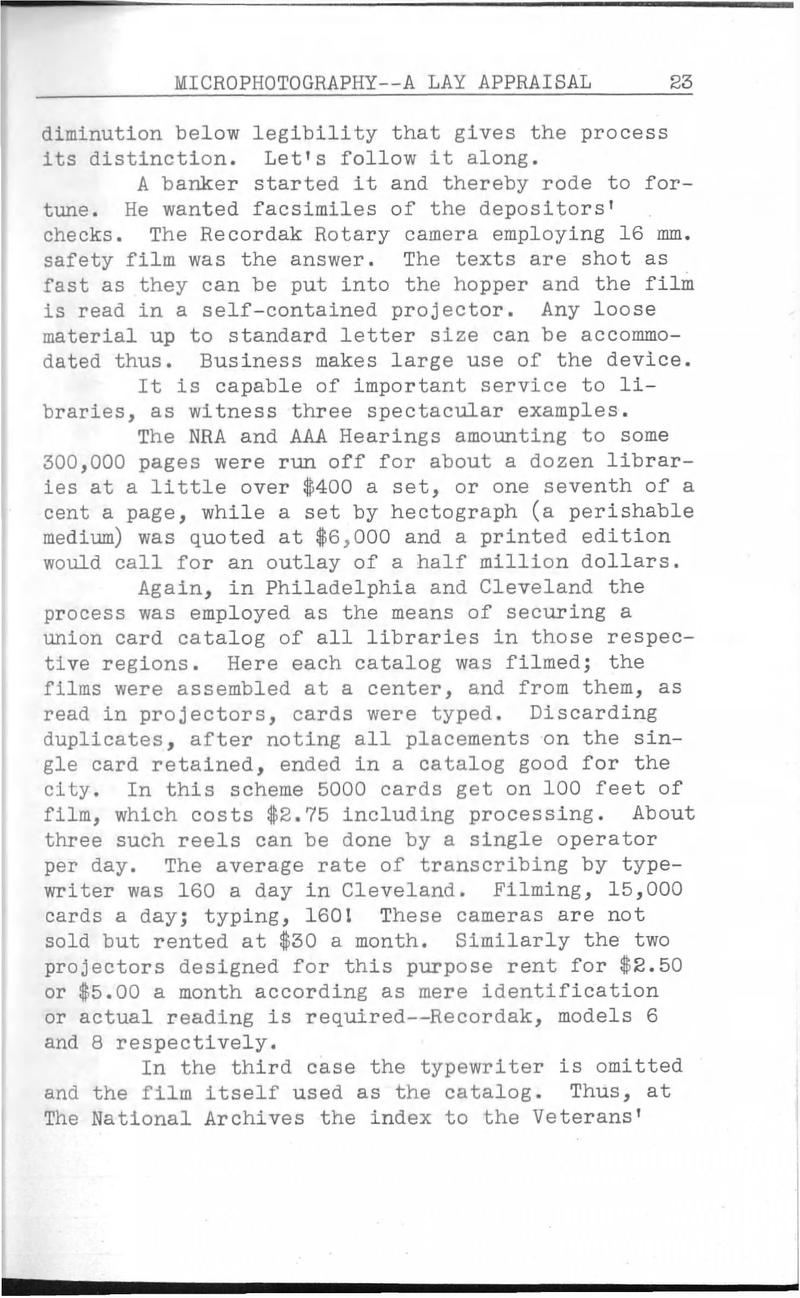 [p. 23] diminution below legibility that gives the process its distinction. Let’s follow it along.
[p. 23] diminution below legibility that gives the process its distinction. Let’s follow it along.
A banker started it and thereby rode to fortune. He wanted facsimiles of the depositors’ checks. The Recordak Rotary camera employing 16 mm. safety film was the answer. The texts are shot as fast as they can be put into the hopper and the film is read in a self-contained projector. Any loose material up to standard letter size can be accommodated thus. Business makes large use of the device.
It is capable of important service to libraries, as witness three spectacular examples.
The NRA and AAA Hearings amounting to some 300,000 pages were run off for about a dozen libraries at a little over $400 a set, or one seventh of a cent a page, while a set by hectograph (a perishable medium) was quoted at $6,000 and a printed edition would call for an outlay of a half million dollars.
Again, in Philadelphia and Cleveland the process was employed as the means of securing a union card catalog of all libraries in those respective regions. Here each catalog was filmed; the films were assembled at a center, and from them, as read in projectors, cards were typed. Discarding duplicates, after noting all placements on the single card retained, ended in a catalog good for the city. In this scheme 5000 cards get on 100 feet of film, which costs $2.75 including processing. About three such reels can be done by a single operator per day. The average rate of transcribing by typewriter was 160 a day in Cleveland. Filming, 15,000 cards a day; typing, 160! These cameras are not sold but rented at $30 a month. Similarly, the two projectors designed for this purpose rent for $2.50 or $5.00 a month according as mere identification or actual reading is required—Recordak, models 6 and 8 respectively.
In the third case the typewriter is omitted and the film itself used as the catalog. Thus, at The National Archives the index to the Veterans’ 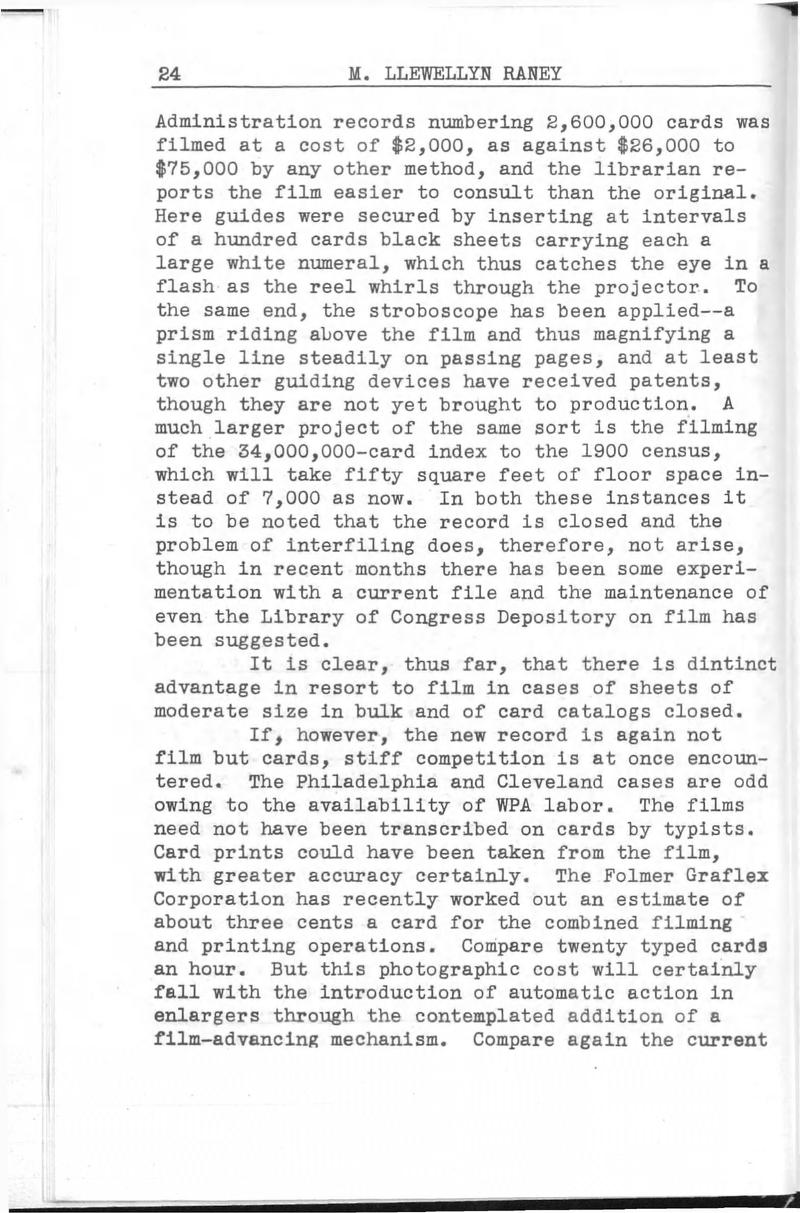 [p. 24] Administration records numbering 2,600,000 cards was filmed at a cost of $2,000, as against $26,000 to $75,000 by any other method, and the librarian reports the film easier to consult than the original. Here guides were secured by inserting at intervals of a hundred cards black sheets carrying each a large white numeral, which thus catches the eye in a flash as the reel whirls through the projector. To the same end, the stroboscope has been applied—a prism riding above the film and thus magnifying a single line steadily on passing pages, and at least two other guiding devices have received patents, though they are not yet brought to production. A much larger project of the same sort is the filming of the 34,000,000-card index to the 1900 census, which will take fifty square feet of floor space instead of 7,000 as now. In both these instances it is to be noted that the record is closed and the problem of interfiling does, therefore, not arise, though in recent months there has been some experimentation with a current file and the maintenance of even the Library of Congress Depository on film has been suggested.
[p. 24] Administration records numbering 2,600,000 cards was filmed at a cost of $2,000, as against $26,000 to $75,000 by any other method, and the librarian reports the film easier to consult than the original. Here guides were secured by inserting at intervals of a hundred cards black sheets carrying each a large white numeral, which thus catches the eye in a flash as the reel whirls through the projector. To the same end, the stroboscope has been applied—a prism riding above the film and thus magnifying a single line steadily on passing pages, and at least two other guiding devices have received patents, though they are not yet brought to production. A much larger project of the same sort is the filming of the 34,000,000-card index to the 1900 census, which will take fifty square feet of floor space instead of 7,000 as now. In both these instances it is to be noted that the record is closed and the problem of interfiling does, therefore, not arise, though in recent months there has been some experimentation with a current file and the maintenance of even the Library of Congress Depository on film has been suggested.
It is clear, thus far, that there is distinct advantage in resort to film in cases of sheets of moderate size in bulk and of card catalogs closed.
If, however, the new record is again not film but cards, stiff competition is at once encountered. The Philadelphia and Cleveland cases are odd owing to the availability of WPA labor. The films need not have been transcribed on cards by typists. Card prints could have been taken from the film, with greater accuracy certainly. The Folmer Graflex Corporation has recently worked out an estimate of about three cents a card for the combined filming and printing operations. Compare twenty typed cards an hour. But this photographic cost will certainly fall with the introduction of automatic action in enlargers through the contemplated addition of a film-advancing mechanism. Compare again the current  [p. 25] rate of ten cents a 6n x 8” paper print from 35 mm. film offered by Bibliofilm Service.
[p. 25] rate of ten cents a 6n x 8” paper print from 35 mm. film offered by Bibliofilm Service.
Three cents is also the cost per card with the photostatic machine known as the Dexigraph, in the Yale Law Library, where, incidentally, curling of cards and difficulty of typing on such stock are reported by Librarian Hicks as substantially conquered, though these headings are paler than the text. Yale was pioneer in this mode through having thus reproduced its main catalog of a million cards in the exodus to Sterling Memorial. This unique camera has had quite a progeny, the latest of which possesses a cradle and handles bound volumes.
This Dexigraph direct paper print is full size, but it need not be. Film tends to dominate the stage at the moment, but sensitized paper in miniature prints has its advantages and these are sure of recognition before long. The standard photostat is a slow, costly, and not very flexible machine. It can reduce but two diameters, that is, to quarter size (one-half height, one-half width). But Dr. Bendikson has adapted the Huntington Library instrument to reduce 3.4 diameters or to nearly one- twelfth size. In this case a text seven inches high would come down to two inches instead of the usual three and one-half inches. If, further, as he points out, such negatives were gathered and a positive of the group taken without further reduction, twelve pages could be got very easily on a 5” x 8” card and read in entire comfort with ordinary hand or desk lenses. Realizing the possibility of paper as well as film, the Graflex company plans in due season to provide their Photorecord camera not only with spools for 35 mm. film but with 70 mm. paper magazines as well. When that is done, then users will have the choice of one-inch film texts to be read by projection and two-inch paper ones managed by light magnifying glasses. It will be an even choice, since paper costs one fourth as much as film. It may very well prove that the paper copies will be  [p. 26] preferred in inter-library service and field work except in long runs and large sizes where economy of materials is necessary. And this says nothing about lower reductions on paper and reading by reflection in Balopticon fashion, upon which research has much work still to do. Keep an eye, therefore, on paper.
[p. 26] preferred in inter-library service and field work except in long runs and large sizes where economy of materials is necessary. And this says nothing about lower reductions on paper and reading by reflection in Balopticon fashion, upon which research has much work still to do. Keep an eye, therefore, on paper.
[…]
 [p. 31] Are we not ready now for the verdict?
[p. 31] Are we not ready now for the verdict?
We prefer the original, if excellent, to a copy if we can afford it. Ah, but that’s a big if. A jury is due all the evidence. So is a scholar or scientist and his countrymen. No library can acquire all or house it. Even if it had unlimited money and space, it still could not succeed, for masses of desirable material are hopelessly out of print or exist in unique archival copies, public or private. Microphotography offers the best present hope of completeness in a specialty at a cost that can be borne. This is its supreme gift.
It saves, too, the present possession that’s threatened with deterioration or injury. This is notably the case with newspapers of the wood-pulp period. And filming in this case renders a third outstanding service in its vast saving of storage space. This ability to contract at command may inaugurate a custom of thus retiring books that have outlived their usefulness and so exert an effect on building plans of the future. The National Archives has decided to film great quantities of purely informational material and keep only 10 per cent of the originals for samples.
Thus, this new skill enables a strategist to mobilize total power with speed, compact it into narrow space, and keep it primed for advance.
Two momentous consequences follow. First, a given institution can have a greater number of complete special collections than ever before and with care these may be made in sufficiently related fields to gather a telling force over a wide sector. The institution might take its character from that sector. So, with others, to fill out a national strategy.
 [p. 32] The other consequence is the ability of the individual specialist, who leaves such a training center and takes this new skill along, to maintain himself anywhere and know that he is part of every advance.
[p. 32] The other consequence is the ability of the individual specialist, who leaves such a training center and takes this new skill along, to maintain himself anywhere and know that he is part of every advance.
Not in five centuries has so gallant a figure appeared on the frontiers of record. He winds a horn destined to be heard round the earth, summoning to joyous entries upon rich regions as yet untrod by man. The ancient Oxford University Press regains its lost titles through his valiant riding, soon to be followed by the youthful University of Chicago Press, thanks to the Library’s lift. Once more may the city dweller’s shallow abode give welcome to great spirits faring, and radio wins a new ally to bring the world to country doors. The author’s shadow is clipped and sent forth living while he sits at home in television. The world contracts, sharpens its vision, and understanding follows.
A paradox, yes, but like Browning’s in Rabbi Ben Ezra, it comforts while it mocks.